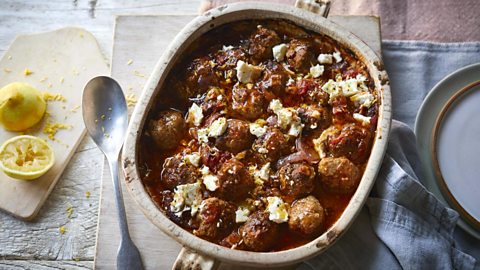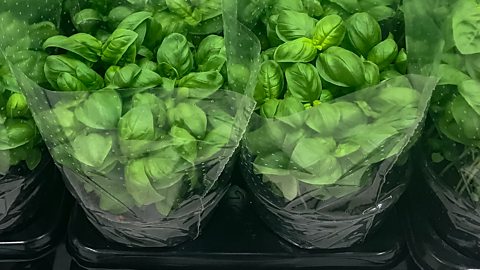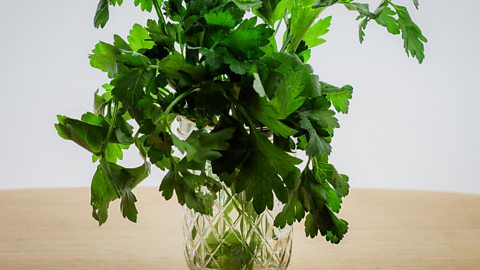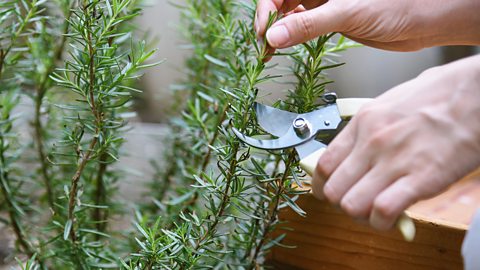The green and easy way to liven up basic recipes
By Sue Quinn
Whether you buy them fresh, dried or grow your own, herbs are great-value ingredients that can transform the simplest of dishesŌĆ”

Herbs are flavour powerhouses: just a sprinkle can ramp up the flavour of any meal. They can turn simple ingredients into tasty dishes, and ring in changes if mealtimes become a bit dull.
ŌĆ£Cooking on a budget often means turning to ingredients that are plentiful and inexpensive, and this can mean eating the same things on repeat,ŌĆØ says Mark Diacono, author of Herb, A Guide To Growing And Cooking With Herbs.
ŌĆ£This is where herbs can really do the hard work for you. They offer a wealth of clothes for even the simplest ingredients to dress up in.ŌĆ£
Boiled new potatoes, for example, have a vibrant fresh flavour when tossed with mint. But they take on a savoury, almost garlicky taste sprinkled with chives, while fresh dill takes them in yet another different flavour direction.
Dried and fresh herbs both deserve a place in your kitchen. But with so many to choose from, and different ways to use them, which ones are worth buying?
Dried herbs
Dried herbs are versatile, inexpensive and sometimes, just as good as ŌĆō or even better than ŌĆō fresh. TheyŌĆÖre best stored in airtight glass jars to keep their aromas in, and away from light, heat and moisture. If stored correctly, dried herbs wonŌĆÖt go ŌĆśoffŌĆÖ but they do lose some of their flavour. When stored in the fridge, theyŌĆÖll keep their flavour and colour for up to a year, and for three months or so in cupboards or drawers.
Dried herbs really come alive when theyŌĆÖre rehydrated. This means you should add them early in the cooking process to give them time to release as much flavour as possible. Or, stir them into salad dressings, dips and sauces and let them sit for 20 minutes before serving.
Diacono recommends two particular dried herbs for their versatility and flavour.
Dried mint has a refreshingly cool and mildly sweet flavour that goes beautiful with dairy. ŌĆ£ItŌĆÖs really useful for adding brightness,ŌĆØ Diacono says. ŌĆ£Try stirring it into raita, a yoghurt and cucumber sauce, or salad dressings.ŌĆØ
Dried mint is also used in Mediterranean cooking to cut through the richness of meaty dishes. Try sprinkling a little into meatball mix and stew. Or jazz up flavourless sliced tomatoes with a shower of dried mint and salt, then leave for 20 minutes for the flavours to develop.
Tasty as it is, donŌĆÖt go overboard with mint, as it can be overpowering. Add small amounts at a time and taste after each addition.
Greek-style meatball bake
Sarah Cook's meatball traybake includes dried mint for a Mediterranean flavour

Dried oregano is highly perfumed with an earthy, slightly bitter flavour. Many people consider it superior to fresh. ItŌĆÖs vital in Italian and Mexican cooking, and has a special affinity with tomatoes. Sprinkle some into a basic tomato sauce made with tinned chopped tomatoes for a quick, cheap and delicious pasta dish. A touch of dried oregano also works beautifully in chilli con carne (as well as veggie versions), aubergines dishes, and paired with chicken or lamb. ŌĆ£Add it early to a stew, or to the onions when youŌĆÖre frying them at the start, to allow time for the flavours to come out,ŌĆØ Diacono suggests.
Dried thyme is another trusty store cupboard standby. ItŌĆÖs an all-rounder that adds punch to any savoury dish, especially roasted vegetables, including carrots and squash, roast chicken and in vegetable stews.
Blends of different dried herbs, such as Herbes de Provence and Italian seasoning, are handy and cost-effective for Mediterranean-style dishes, and save you buying lots of individual jars.
Related stories
Fresh herbs

An array of fresh herbs is now sold in supermarkets and greengrocers, either cut in packets or ŌĆśliving herbsŌĆÖ in pots. In 2022, coriander is said to be the nationŌĆÖs favourite, accounting for almost one-third of all fresh herbs sold, according to Kantar Worldpanel. This is followed by parsley (17 percent), basil (16 percent) and mint (10 percent).
ŌĆ£Cut herbs are a great starting point for cooks wanting to try new recipes,ŌĆØ says Sarah Pitts, senior technical manager for herb supplier, Vitacress. ŌĆ£Living herbs are usually chosen by more confident cooks who like the longevity and multi-use aspect.ŌĆØ
Fresh herbs are divided into two general types: soft/tender and hard/woody.
Tender herbs such as parsley, coriander, basil, tarragon and dill have fleshy edible stems, and you can eat them raw and cooked. The leaves are fragile, so pick them off the stems gently, then chop or tear and add towards the end of cooking, so the flavour isnŌĆÖt damaged by heat.
DonŌĆÖt throw the stems away ŌĆō theyŌĆÖre packed with flavour and belong in your food, not the bin. ŌĆ£Finely chopped and thrown in at the start of cooking, they add loads of flavour that will complement the brighter notes of the leaves you add at the end,ŌĆØ Diacono says.
Woody herbs such as thyme and rosemary have tough stems and strong oily flavours, and arenŌĆÖt suitable for serving raw. Add whole sprigs to soups and casseroles or tuck them into the roasting tray with vegetables or potatoes, chicken or meat. The heat will help break down the cells in the leaves so the fragrant oils emerge as the food cooks. Just fish out and discard the sprigs when the dish is ready. Alternatively, strip the leaves from the stems and finely chop before adding to the pot.
No waste

Fresh herbs can be more expensive than dried, but are still good value if you store them well and minimise waste. Catherine Phipps, food writer and author of Leaf, A Guide To Culinary Leaves, suggests storing herbs as soon as possible after shopping, unless you plan to use them immediately.
ŌĆ£Put some water in a jar, add the herbs so the stems sit in the water, cover with a plastic bag and seal with an elastic band,ŌĆØ she says. ŌĆ£If you have space, keeping them upright in the fridge door will keep them fresh for three to four days.ŌĆØ The exception to this rule is basil, which quickly blackens at fridge temperature, so best to keep it out.
If you know you wonŌĆÖt get through a whole packet or bunch, pinch the leaves and soft sprigs off the thicker stems. Bunch the stems together and store in an airtight tub in the freezer. ŌĆ£If you leave the stems long theyŌĆÖre brilliant for adding to stock or, finely chopped, you can add them to many dishes,ŌĆØ Phipps says.
If you buy living herbs from the supermarket, remove the plastic and leave in a sunny spot on a saucer. ŌĆ£Water little and often from the base,ŌĆØ Pitts recommends. ŌĆ£Be careful not to over-water living basil, which should only be watered when the compost feels dry to the touch. In the summer, the potted herbs can be planted in the garden.ŌĆØ
So how long can you expect living herbs to last? John Benfield, Head of Horticultural Operations at Vitacress explains: ŌĆ£Living herbs have a limited lifespan in a pot due to limited nutritional availability. However if they are watered, placed in sunlight and at the right temperature, they will easily last six weeks plus.ŌĆØ
Substitutes
Missing a particular herb in a recipe? Just swap one soft herb for another, and likewise for woody ones. As a general rule, this wonŌĆÖt make a big difference to your dish, ŌĆ£although I wouldnŌĆÖt use dill as a substitute for another herb, as it has a bit of a peculiar flavour, which is terrific for a few specific uses but not everything,ŌĆØ Diacono says.
If youŌĆÖre missing a fresh herb but have the dried version, or vice versa, substitute one for the other: one tablespoon chopped fresh herbs is roughly equivalent to one teaspoon dried.
Grow your own

If you have the space, perennial woody ones like rosemary, sage and mint are safe bets, says Leigh Hunt, principal horticultural advisor at the Royal Horticultural Society (RHS).
ŌĆ£TheyŌĆÖre really easy to grow and you can you buy starter pots for as little as ┬Ż1.50 at the supermarket,ŌĆØ he says. ŌĆ£Once you put them in the garden, you really donŌĆÖt have to do much and theyŌĆÖll last 5 to 10 years. They also grow well in pots, just keep them well watered, especially in hot weather.ŌĆØ They wonŌĆÖt grow much in winter, but bring them inside to protect against the frost, and they will give you flavour all year round.
Soft herbs can be trickier, but worth a try. Hunt says the easiest to grow is parsley, which favours a cool and sheltered spot, such as a porch or outside covered area. ŌĆ£Seeds are very cheap and robust,ŌĆØ he says. ŌĆ£Just scatter over a pot of compost or in the garden in early spring.ŌĆØ Protect the young herbs from snails and slugs, but once grown and hardy, they'll look after themselves.
Originally published November 2022